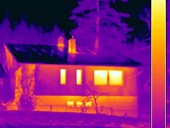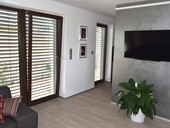The following contributions, which deal with this problematic, consider the impact of high heat resistance of the walling on the thermal comfort and the design of heating ventilations systems, which are still perceived, as it is the case in buildings with classical walling, therefore, to have lower thermal resistance. For instructions to formulate the effect of walling on the thermal comfort and technical equipment, a general comparison of both the following cases is made, which is simply called building with high thermal resistance of external walls for a low-energy house, and a building with classical walling parameters (e.g. housing estate from the past) as a standard house. The articles are not of exact technical nature and deal with regularly updated dependencies and sometimes refer to previously applicable legal provisions.
Archiv článků od 1.6.2009 do 22.2.2010
The ČSN EN ISO 13370 Thermal performance of Buildings – Heat Transfer via the ground – Calculation methods has been valid since 2000. Until 2008 it was concurrent with the ČSN 06 0210, which was used to floor structures on soil. After its repelling, the above mentioned ISO standards became the only applicable basis for the design and evaluation of floor constructions and the conclusions arising from their use are not yet sufficiently known among the scientific community. The use of these ISO standards introduces entirely new principles of design, which are vastly different from those that have been used for several decades. The article illustratively solves the problem of the calculation of the heat transfer coefficient from floor structures built on the ground, focusing mainly on surface (indoor) objects.
The following contributions, which deal with this problematic, consider the impact of high heat resistance of the walling on the thermal comfort and the design of heating ventilations systems, which are still perceived, as it is the case in buildings with classical walling, therefore, to have lower thermal resistance. For instructions to formulate the effect of walling on the thermal comfort and technical equipment, a general comparison of both the following cases is made, which is simply called building with high thermal resistance of external walls for a low-energy house, and a building with classical walling parameters (e.g. housing estate from the past) as a standard house. The articles are not of exact technical nature and deal with regularly updated dependencies and sometimes refer to previously applicable legal provisions.
We can observe in the Czech press a significantly higher frequency of expressions suchs as passive house or energy-efficient construction, specially in connection with the subsidy program “Zelená Úsporám”. However, the reality is that the number of passive houses built is very low, moreover, in some of the so called passive houses there can certainly be doubts about their actual properties.
The important factor during the process of the preparation and the realization of the buildings is the knowledge of the legal regulations that solve the safety at construction. The solving of safety begins already during the preparation of the building plan. The investor should find out whether the planned construction is a kind of constructions for that a coordinator for safety at construction must be established. It must be distinguish to which extend and for which constructions the legal regulations refer and wheather they also refer to houses.
In the first half of this year new came in force new standards that define new requirements for the design of thermo insulation systems in buildings. They are ČSN 73 0810 - Fire safety of buildings - Common provisions (April 2009) and ČSN 73 0802 - Fire safety of buildings- Non industrial buildings. The changes in these standards bring a number of major innovations. Let's have a look with them with the aid of images.From the result it is evident that the implementation of external thermal insulation systems for buildings with final approval before 200, and new buildings must follow the additional requirements listed in the articles of the standards ČSN 73 0810 and ČSN 73 0802, particularly in relation to the classification of types of components on the DP1, DP2, DP3. The implementation of additional insulation requires good design, preferably done by a specialist, the application of comprehensive quality and the choice of contractors with certifiable good references.
The article reacts on changes that were made in program "Zelená úsporám" in recent days. Previous article described how to reach required standards for successful subsidy application in two ways. Following text focuses on changes in this approach both from subsidy amount and possibility of subsidy itself viewpoints. In general, portfolio of potential subsidy applicants has been extended, but necessary quality of subsidized measures has been kept.
The examination method Blower-Door test (fan pressurisation method) is used for measurements of air permeability of buildings and is also used for leakage detection. The result of the measurement is air leakage rate at the pressure differential across the building envelope of 50 Pa. The article points out leaky details which often appear at constructions. The article shows the possibility of using infrared camera and anemometer for leakage detection.
New Czech technical standard ČSN 73 0810 Fire protection of buildings - General requirements was issued in April 2009. This standard replaced the standard of the same title issued in June 2005. New standard has expanded or changed some of the paragraphs. Important changes are defined in the article.
Growing interest insulation very often results in choosing companies with low price for materials and installation, without considering whether technological standards are observed. The analysis of defects occurring in contact insulation systems should warn investors on how to proceed when choosing a supplier, so as to avoid claims for the resulting defects, or in a extreme case, so the insulation will not have to be replaced. It also wants to draw the attention of suppliers and designers towards those major faults when installing the contact insulation, and bring awareness to the general public about deficiencies that could arise, in particular with the implementation of contracts with no technical supervision.
Thermographic measurements and their subsequent diagnosis are a relatively quick method of non contact evaluation of buildings related to heating technology. Thermal images show complex temperature fields with optional colour scales and are thus very easy to understand even for a layman. The assessment and analysis of the temperature distribution allow the identification of places with elevated heat flow.
Different prediction methods for the Sound Reduction Index of single building structures in laboratory conditions and for the Apparent Sound Reduction Index in buildings are presented in following paper. A short discussion of methods is done regarding to input data, assumptions of calculations etc. The main part of this paper is focused on a comparison between predicted and measured results, which leads to evaluation of methods´ accuracy. This paper is based on author´s PhD thesis.
zpět na aktuální články

